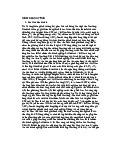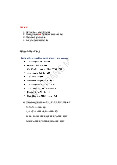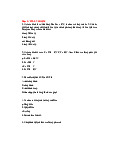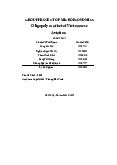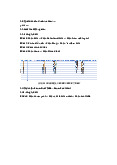



















Preview text:
MINISTRY OF EDUCATION & TRAINING HOA SEN UNIVERSITY GROUP PROJECT Macroeconomic Topic:
The situation of controlling inflation in Vietnam from 2020 to 2023 Instructor Phùng Thế Vinh Class 1093_2331 Group 5 Đàng Thục Huệ - 22206966
Nguyễn Thị Hường – 22207436
Bùi Thị Hồng Ngọc – 22205445 Group members
Trầm Thị Tiền Phương – 22205278
Nguyễn Thị Thu Nga – 22206678
Nguyễn Hoàng Thanh Nhã - 22205996 Ho Chi Minh, December 2023 ABSTRACT
This essay delves into the intricate landscape of controlling inflation in
Vietnam and the global economy, spanning the pivotal years from
2020 to 2023. Focused on macroeconomic dynamics, the study
explores the multifaceted strategies and challenges faced by the
Vietnamese government in managing inflation within the backdrop of
significant economic shifts and global uncertainties. It scrutinizes the
interplay of domestic and external forces, including government
policies, global economic trends, and the dynamic nature of Vietnam's economy.
The analysis extends beyond Vietnam's borders to encompass the
global scenario, tracking the trajectory of inflation from the initial
impacts of the COVID-19 pandemic in 2020 to the complex challenges
faced in 2023. The essay examines the concerted efforts of
governments worldwide in implementing policies to curb inflation
amidst geopolitical tensions, supply chain disruptions, and evolving economic landscapes.
Through a comprehensive exploration of the policies enacted by the
Vietnamese government, including interest rate support, tax and fee
reviews, and structural reforms, the study evaluates their
effectiveness in maintaining economic stability and managing
inflation. The global perspective emphasizes the necessity for
cautious monetary policies on a worldwide scale, urging countries to
remain vigilant until inflation reaches sustainable levels.
In essence, this essay provides a nuanced understanding of the
macroeconomic strategies employed by Vietnam and the global
community to control inflation during a transformative period. It offers
insights into the challenges faced, the effectiveness of policy
measures, and the implications for future economic landscapes,
contributing to a broader comprehension of macroeconomic dynamics in a rapidly changing world. 1 TABLE OF CONTENTS
ABSTRACT.............................................................................................1
TABLE OF CONTENTS............................................................................2
ACKNOWLEDGEMENT...........................................................................4
FIGURES................................................................................................5
TABLE...................................................................................................6
TASK ASSIGNMENT...............................................................................7
INTRODUCTION.....................................................................................8
1. THEORETICAL BASIS OF INFLATION................................................9
1.1 Definition of inflation................................................................9
1.2 Reason cause to inflation..........................................................9
1.2.1 Demand-pull........................................................................9
1.2.2 Cost-push............................................................................9
1.2.3 Inflation expectations..........................................................9
1.3 Consequences of inflation.........................................................9
1.4 Solutions to control inflation...................................................10
2. SITUATION OF VIETNAM’S INFLATION FROM 2020 TO 2023.........10
2.1 The situation of inflation in Vietnam from 2020 to early 202310
2.2 The policies of the Vietnamese government to control the
inflation rate....................................................................................13
2.2.1 Promote 2% interest rate support policy...........................13
2.2.2 Review tax and fee reduction...........................................13
2.2.3 Implement restructuring in most fields.............................13
2.2.4 Complete for the difficulties of production and business. .14 2
2.3 Forecasting the inflation rate in Vietnam at the conclusion of
the year 2023..................................................................................14
2.3.1 Forecast of the Asian Development Bank (ADB)...............14
2.3.2 Forecast by Dr. Nguyen Duc Do - Deputy Director of the
Institute of Financial Economics...................................................15
2.3.3 Forecast by Dr. Nguyen Bich Lam - Former Director
General of the General Statistics Office........................................16
3. SITUATION OF THE WORLD’S INFLATION AND THE SOLUTIONS
FOR VIETNAM.....................................................................................17
3.1 The situation of inflation in the world from 2020 to early 2023 17
3.1.1 The situation of the inflation in the world from 2020 to 2022 17
3.1.2 The situation of inflation in the world from early 2023.....18
3.2 The policies of the world government to control the inflation rate 19
3.3 Solutions for Vietnam’s situation............................................19
4. THE TRENDS IN INFLATION FOR VIETNAM AND THE WORLD IN THE
NEAR FUTURE, 2024-2025..................................................................20
4.1 Economic experts's forecasts of Vietnam’s inflation trends....20
4.2 Economic experts's forecasts of global inflation trends..........21
CONCLUSION......................................................................................22
REFERENCES......................................................................................24 3 ACKNOWLEDGEMENT
First of all, We would like to send to the lectures of Hoa Sen University
our sincerest and deepest thanks.
In particular, We would also like to give our warmest thanks to the
lecture, Mr Phung The Vinh. You have wholeheartedly guided us in the
learning process as well as in completing the thesis. We could not
have completed this essay without you.
We have tried to complete this essay, but errors may not be avoided.
We respectfully hope to receive advices from lectures to improve the article. 4 FIGURES
Figure 2.1 CPI growth rate in 2020 (%)..............................................10
Figure 2.2 CPI growth rate of the years in the period 2016 - 2021 (%)
...........................................................................................................11
Figure 2.3 CPI growth quarterly and monthly.....................................12
Figure 2.4 Average CPI growth rate in months of 2023 (%)...............13
Figure 2.5 Prime Minister Pham Minh Chinh and Deputy Prime Minister
Le Minh Khai chaired the meeting on maintaining macroeconomic
stability, controlling inflation, promoting growth and ensuring major
balances of the economy...................................................................14
Figure 2.6 View of the workshop........................................................15
Figure 3.1 Global inflation rate in 2019 – 2022..................................17
Figure 3.2 Inflation rate in the United States in 2019 – 2022.............18
Figure 4.1 Expected average CPI inflation in Vietnam.......................20
Figure 4.2 Inflation rates around the world are forecast to have
peaked................................................................................................21 5 TABLE
Table 1. Task Assignment.....................................................................7 6 TASK ASSIGNMENT N Student Name Assigned tasks Evalua Note o. ID te number 1. 2220696 Đàng Make outline 100% Team 6 Thục Huệ leader Prepare content for abstract, task assignment, introduction, conclusion. Synthesize information & Make Word report 2. 2220743 Nguyễn Make outline 100% 6 Thị Hường Prepare content for part.3 Summary information & Make PowerPoint presentation 3. 2220544 Bùi Thị Prepare content for 100% 5 Hồng acknowledgement Ngọc and part 1 4.
2220527 Trầm Thị Prepare content for 80% Absent in 8 Tiền part 2 and part 4 the Phương presentat ion day 5. 2220667 Nguyễn Prepare content for 100% 8 Thị Thu part 2 and part 4 Nga 7 6. 2220599 Nguyễn Prepare content for 100% 6 Hoàng part 2 and part 4 Thanh Nhã
Table 1. Task Assignment 8 INTRODUCTION
The global economic landscape is an intricate tapestry woven with
numerous threads of interconnected factors, where the delicate
balance of inflation plays a pivotal role in shaping nations' prosperity.
This essay embarks on a journey through the years 2020 to 2023,
scrutinizing the complex dynamics of controlling inflation in both
Vietnam and the global economy. Against the backdrop of the COVID-
19 pandemic's unprecedented disruptions, this period unfolds as a
critical juncture marked by challenges, transformations, and strategic responses.
In the Vietnamese context, the government grapples with the task of
managing inflation within a rapidly evolving economic terrain. A
synthesis of domestic policies, global economic trends, and the
inherent dynamism of Vietnam's economy forms the crux of our
exploration. As the nation strives for sustained growth and stability,
the study delves into the multifaceted strategies implemented by the
Vietnamese government, ranging from interest rate support to tax and fee reviews.
Zooming out to the global stage, the essay extends its gaze beyond
borders, capturing the trends and intricacies of inflation from 2020 to
2023. It navigates through the ripple effects of the pandemic,
geopolitical tensions, and shifts in supply chains, offering a panoramic
view of the challenges faced by nations worldwide. The concerted
efforts of governments on the global front to curtail inflation become
a focal point, emphasizing the significance of coordinated strategies in an interconnected world.
In essence, this exploration encapsulates the essence of
macroeconomic intricacies during a transformative period, shedding
light on the nuances of inflation control and its implications for both
Vietnam and the global community. As we unravel the layers of
economic strategies and responses, a comprehensive understanding
emerges, poised to inform future policymaking and contribute to the
broader discourse on navigating economic complexities. 9
1. THEORETICAL BASIS OF INFLATION 1.1 Definition of inflation
Inflation is a general increase in prices, which can be understood as a
fall in the purchasing value of money. The amount of decrease in
purchasing power can be thrown back in the average lift in price of a
chosen basket of goods and services. A growth in price indicated\ a
percentage that one unit of currency buys lower than in perior
periods. Inflation is the opposite of deflation. Deflation happens when
prices decrease and purchasing power increases. 1.2
Reason cause to inflation
The main reasons of inflation can be divides into three foremost
types: Demand-pull, Cost-push, Inflation expectations 1.2.1 Demand-pull
'Demand-pull inflation’ is due to evolutions on the demand side of the
economy, while ‘cost-push inflation’ is caused by the result of higher
input costs on the provision side of the economy. Inflation can also
effect from ‘inflation expectations’, what households and businesses
think will occur to costs in the future can real influence costs in the
future. These different causes of inflation are reflected by the Reserve
Bank when it investigates and guesses inflation. 1.2.2 Cost-push
Cost-push inflation occurs when general prices increase due to rises in
the cost of salaries and primal matter. Higher costs of production can
decline the amount of total production in the economy. The demand
for goods hasn't changed, so the priceses from manufacture are
passed onto costumers creating cost-push inflation. 1.2.3 Inflation expectations
Inflation expectations are the amount at which consumers,
businesses, investors—expect prices to rise in the future. They
important because actual inflation relies on what we expect it to be. If
everyone wants prices to rise, example, 3% over the next year,
businesses will want to raise prices by at more than 3 percent, and
workers will want alike-sized raises. If inflation expectations increase
by 1%, actual inflation will increase by 1% as well. 10 1.3
Consequences of inflation
Inflation has a negative effect on the economy. It devalues currency,
rises prices of goods and services, reduces people's purchasing
power, disrupts business and investment plans, and creates instability in the business environment. 1.4
Solutions to control inflation
Stop Digging: Don't make the inflationary environment worse and
avoid adding more to the deficit, whether through a gas tax holiday,
expanded veterans benefits, new tax cuts, etc.
Reform the Tax Code to Raise More Revenue: Tax rises can reduce
demand in a command way, limiting inflationary pressure. Inflation
can be reduced by attached tax expenditures and aids that get specific costs in the economy.
Lower Energy, Trade, and Procurement Costs: Government policies
and regulations can influence the before- or after-tax price of various
goods and services. Beyond the normal supply and demand, policies
can effect the economy like control inflation by ensuring it's getting the best cost.
2. SITUATION OF VIETNAM’S INFLATION FROM 2020 TO 2023 2.1
The situation of inflation in Vietnam from 2020 to early 2023
2020 is the year the Covid - 19 pandemic has complicated changes,
thus strongly affecting the growth of different business fields and industries.
The inflation rate in Vietnam in 2020 increased slightly by 2.31%
compared to the average in 2019. This has achieved the target set by
the National Assembly of less than 4%. Regarding the macro
economy, the Government has properly operated and directed so that
Vietnam grows more positively with guaranteed macro indicators. 11
Based on the forecast of the International Monetary Fund (IMF),
inflation in Vietnam in 2022 will increase by 3.9%, close to the
Figure 2.1 CPI growth rate in 2020 (%)
previously set state control target of 4%.
Source: GENERAL STATISTICS OFFICE
Vietnam's inflation rate 2021
According to the General Statistics Office, the consumer price index
(CPI) in December 2021 increased by 0.1% over the previous month
and increased by 0.19% over the same period last year. On average
in 2021, the consumer price index increased by 3.23% compared to
2020. Explaining the increase in December CPI index, according to
the General Statistics Office, domestic gasoline and gas prices
increased according to world fuel prices; Rice prices increased
according to export rice prices and increased consumer demand at
the end of the year were the factors that caused the CPI to increase by 0.1%.
Average core inflation in 2021 increased by 2.31% compared to the
average in 2020, reaching the target set by the National Assembly of
less than 4%. In macro management, the Government always gives
correct direction and promptly prevents CPI increase right from the
beginning of the year. Specifically, the Government implemented a
series of support packages for businesses and workers, overcoming
the negative impacts of the COVID-19 epidemic such as reducing
electricity prices; Ensuring supply and demand of pork, 12
Figure 2.2 CPI growth rate of the years in the period 2016 - 2021 (%)
Source: GENERAL STATISTICS OFFICE
Vietnam's inflation rate 2022
Inflation developments in 2022 The Consumer Price Index (CPI) in
2022 compared to the same period last year tends to increase
continuously over the months, decreasing the growth rate in February
and August, respectively 1.42 % and 2.86%. Immediately after that,
the months of March and September saw the CPI increase compared
to the same year in 2021 at a rate of 1.5 times. Observation can see
that the cycle of the first 6 months of the year and the last 6 months
of 2022 are almost similar, but the level is lower.
The reason for the increase or decrease in CPI in the first half of 2022
is because the prices of food products in the first 6 months of the year
decreased by 0.4% over the same period last year, causing CPI to
decrease by 0.08 percentage points, of which the price of pork
decreased by 20.12%. Pork prices have dropped sharply mainly
because Vietnam has produced an African swine fever vaccine 13
However, by the end of the fourth quarter of 2022, the average CPI in
2022 increased by 3.15% compared to 2021, completing the target
set by the National Assembly, influenced by many reasons to restrain
prices as well as increase prices.
Figure 2.3 CPI growth quarterly and monthly
Source: Health & Life is the mouthpiece of the Ministry of Health
Inflation in 2023 is forecast to be about 2.5% - 4%
At the conference "Price market developments in Vietnam in the first
6 months of the year and forecast for the whole year 2023" held on
July 4, economic experts predicted that average inflation in 2023 would be low, about 2.5% - 4%.
According to data from the General Statistics Office, the average
consumer price index (CPI) in the first 6 months of 2023 increased by
3.29% compared to the same period in 2022; Core inflation increased
by 4.74%. This is a relatively low CPI index in a context where
inflation in many countries around the world is still high and the
prices of many products such as raw materials and fuel inputs to production have increased.
Dr. Nguyen Duc Do pointed out 3 factors "repressing" the increase in
inflation in the first 6 months of 2023: Economic growth rate and
money supply growth are low, real interest rates are too high. 14
Economic expert Vu Vinh Phu said that the overall picture of CPI in the
last 6 months of 2023 will reach 3.8-4%, contributing to stabilizing the
macroeconomy and controlling inflation...
Figure 2.4 Average CPI growth rate in months of 2023 (%)
Source: GENERAL STATISTICS OFFICE 2.2
The policies of the Vietnamese government to
control the inflation rate 2.2.1
Promote 2% interest rate support policy
The State Bank of Vietnam presides over and coordinates with
ministries, agencies and localities to implement prudent and firm
monetary policies, ensuring initiative, flexibility, efficiency, close
coordination and effectiveness. effective with fiscal policy and other
policies to control inflation, stabilize the macroeconomy, and
contribute to promoting growth. 2.2.2
Review tax and fee reduction
The Ministry of Finance presides and coordinates with ministries,
agencies and localities to implement reasonable, focused and focused
fiscal expansion policies, ensuring effectiveness; Promote increased
revenue, expand revenue base, and strengthen prevention of revenue loss 2.2.3
Implement restructuring in most fields
The Government requests the Ministry of Industry and Trade to
preside over and coordinate with ministries, agencies and localities to 15
closely monitor supply and demand developments and the market
situation of essential goods, especially gasoline and oil; There are
solutions to prevent supply disruption and meet domestic production and consumption needs. 2.2.4
Complete for the difficulties of production and business
The Government requires ministries, branches ,localities, based on
their assigned functions, tasks and powers, to thoroughly grasp the
viewpoint of proactive, flexible, timely, creative and effective
macroeconomic management. appropriate to the situation and
practical requirements in the direction of: ensuring stability in
uncertain conditions; Maintain a proactive position in the face of complex , developments
Figure 2.5 Prime Minister Pham Minh Chinh and Deputy Prime Minister
Le Minh Khai chaired the meeting on maintaining macroeconomic
stability, controlling inflation, promoting growth and ensuring major
balances of the economy.
Source: Government Electronic Newspaper 2.3
Forecasting the inflation rate in Vietnam at the
conclusion of the year 2023 2.3.1
Forecast of the Asian Development Bank (ADB)
On July 19, 2023, the Asian Development Bank (ADB) made a decision
in its Asian Development Outlook report to forecast a growing
regional growth rate in Asia, in the context of Falling fuel and food 16
prices, improving supply chain disruptions and rising interest rates
starting to take hold. According to the report, Vietnam's economic
growth rate is expected to reset at 5.8% in 2023 and 6% in 2024, so
the recovery forecast in April 2023 is 6% respectively. .5% and 6.8%,
mainly weakening external demand.
The report notes that the main factors affecting the economy include
the global economic recession, monetary tightening in some
developed countries and increasing global geopolitical tensions.
Inflation forecasts are revised down from 4.5% to 3.8% for 2023 and from 4.2% to 4% for 2024.
ADB country director for Vietnam, Mr. Shantanu Chakraborty said:
“The weak external environment has negatively affected Vietnam's
export-oriented manufacturing sector, shrinking industrial production.
However, the economy remains resilient and is expected to recover
quickly in the near future thanks to strong domestic consumption,
supported by moderate inflation, accelerated disbursement of public
investment and improved economic conditions. commercial activities”. 2.3.2
Forecast by Dr. Nguyen Duc Do - Deputy Director of
the Institute of Financial Economics
Commenting on the domestic inflation situation, Dr. Nguyen Duc Do,
Deputy Director of the Institute of Financial Economics, said that a
cautious monetary policy in 2022 along with the risk of the world
economy falling into recession in 2023 will make inflationary pressure
Figure 2.6 View of the workshop this year not too great. 17
Source: People’s Army Newspaper
"Inflation over the same period last year is likely to peak in January
2023 and then return to the average level of the period 2016 - 2022,
about 3%. Average inflation in 2023 is forecast to at about 3.5%",
according to Dr. Nguyen Duc Do. Dr. Nguyen Duc Do said that it can
be said that inflation pressure in Vietnam in 2023 will not be too
great. Because, pressures on inflation from variables such as
currency, exchange rates or fuel and raw materials are likely to have
peaked in 2022 and will decrease in 2023.
Sharing the same opinion, Associate Professor, Dr. Ngo Tri Long also
emphasized that the consumer price index in 2022, increasing by
3.15% compared to 2021, is the brightest point of the Vietnamese
economy in 2022; controlling a relatively low inflation rate in the
context of the world struggling to cope with hyperinflation and "price storms".
Emphasizing that Vietnam belongs to the group of countries with low
inflation, while world inflation continues to increase, Associate
Professor, Dr. Ngo Tri Long said: Looking at the average annual CPI
data for 5 years (2018-2022). ), we see that CPI does not fluctuate
much and tends to move sideways.
Meanwhile, fuel prices, especially gasoline prices, are forecast to cool
down in 2023; China opens its economy after implementing zero
Covid. Meanwhile, agricultural production in our country is still
developing quite well, GDP in 2022 will increase by 8.02% - the
highest increase in more than 10 years...
"Therefore, the average CPI in 2023 compared to 2022 will likely
remain at 3.2 - 3.5%, below the target set by the National Assembly,
which is completely feasible," Associate Professor, Dr. Ngo Tri Long said. 2.3.3
Forecast by Dr. Nguyen Bich Lam - Former Director
General of the General Statistics Office
International financial organizations predict that gasoline prices are
likely to increase in the near future. The Organization of Petroleum
Exporting Countries and its partners decided to cut production and
the Russian Federation announced it could cut oil production by 5%-
7% in early 2023, which will impact oil prices on the market. world (Thuc Anh, 2022).
Domestic electricity prices have been kept from increasing over the
past few years, while coal and gas prices used in electricity
production have increased. Thermal power structure and gas power 18
account for a large proportion of total electricity generation.
Therefore, it is time for the Government to adjust electricity prices
and create resources to provide enough electricity for the needs of
the economy. If electricity prices increase in 2023, it will put pressure
on inflation by increasing production costs and final consumption
expenditures, while reducing economic growth. According to
calculations, if electricity prices increase by 8%, inflation will increase
by 0.5%; If electricity prices increase by 10%, inflation will increase by 0.61%.
On November 11, 2022, the National Assembly passed a Resolution
on the state budget estimate for 2023. Accordingly, from July 1, 2023,
the base salary increases from 1.49 million VND/month to 1 8 million
VND/month, equivalent to a 20.8% increase in the new base salary,
which will increase inflation by 0.67%.
Inflation pressure in 2023 also comes from the ability to adjust
according to the roadmap to increase prices of services managed by
the State such as education and health services.
The price index of raw materials and fuels used for production in 2022
increased by 6.79% compared to 2021 and the price index of
imported goods increased by 8.56%, leading to the producer price
index of agricultural, forestry and aquatic products production
increased by 3.89% compared to the previous year; Industrial product
producer price index increased by 4.24%; Service producer price
index increased by 3.69%. The producer price indexes of the three
regions all increased higher than the average inflation of 3.15% in
2022, which will spread to consumer prices in 2023.
In addition, a number of policies to help stabilize production and
business activities of enterprises and people's lives will end in 2022;
Natural disasters and epidemics can affect food prices in some
affected localities, which will also increase CPI.
Based on the above impact factors, the forecast inflation rate in 2023
of Vietnam's economy may be at 4.5%-5%, however in the medium
term of 5 years 2021-2025 inflation will reach the target. The planned target is about 4%. 19
